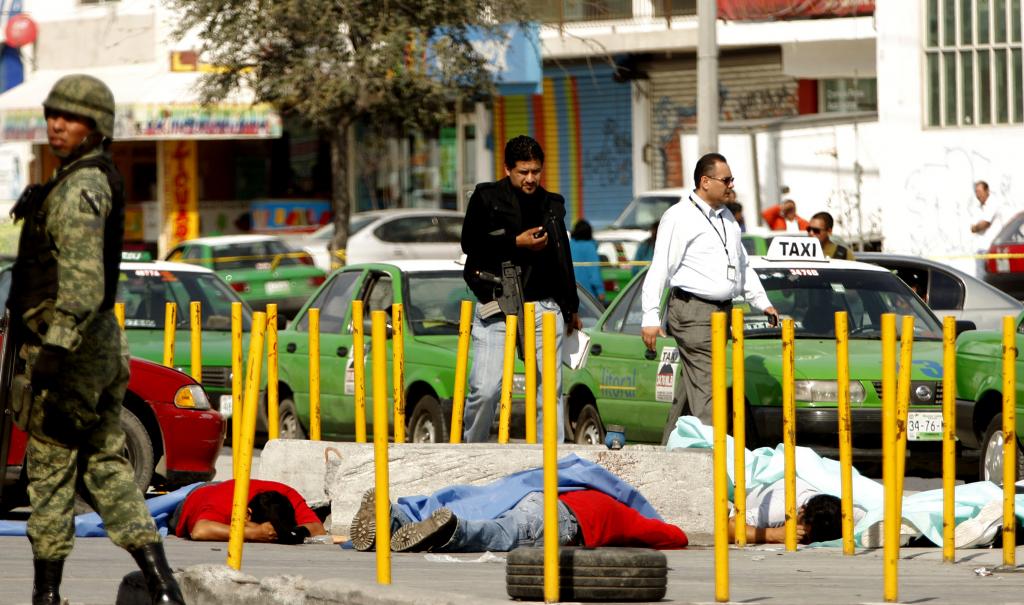A seemingly bewildering array of forms of violence confronts us in the 21st century. Large-scale gang warfare in Central America, Western interventions in Afghanistan and Iraq, hybrid warfare in eastern Ukraine, terrorist attacks in Europe, civil war in Syria, or armed militias in the Democratic Republic of the Congo – all seem to portray a world of ever-greater danger. Yet just how violent are contemporary global politics, and how – if at all – have armed conflict and political violence changed since the end of the Cold War? Three facts will help us answer the first question; the second is more complex.
To begin: most contemporary lethal violence does not occur in conflict zones, but in states that are not at war. Non-conflict settings such as El Salvador, Venezuela, and Honduras have higher levels of deadly violence than war zones (excepting Syria and Iraq). According to the Small Arms Survey’s Global Violent Deaths 2017 report, 560,000 people died violently in 2016, but only about 100,000 (18%) were killed in war zones. Even if this number is misleadingly low (because it omits the indirect but still lethal burden of war), it shows that war is only one piece of a larger puzzle of contemporary armed violence, much of which is organised, non-random, and in some sense political. This contrasts sharply with the 20th century and its 60–80 million deaths by war and roughly 100 million deaths by “state violence”.
How should we try to understand these diverse forms of violence? Three traditional limitations to the study of violence need first to be overcome.
The first limitation is the compartmentalisation of violence studies: interstate and civil war and organised armed actors are covered by international relations, gangs by sociology or anthropology, organised crime by criminology, and sexual and gender-based violence by gender studies. This compartmentalisation hinders our understanding of the way seemingly different forms of violence may be linked through complex processes that escalate and exacerbate conflicts, and that may have broader impacts on human security, political and social life, state fragility, and regional order. Sexual violence in (and after) conflicts, for example, is related to other forms of violence, and this relationship is not one-way, with war causing higher levels of sexual and gender-based violence. There are deeper processes at work, as states with lower levels of gender equality and higher levels of gender-based violence are more likely to be involved in interstate conflicts or to initiate the use of force, and are less likely to comply with international norms. Likewise, the rituals, organisational forms, and modes of action of some South American gangs would resonate with those of West African warlords, for instance.
The second limitation is to draw a sharp distinction between political and non-political (criminal, interpersonal, economically motivated) violence. This narrowly criminological or legalistic perspective, which labels all non-conflict deaths as “homicides”, is misleading. Homicide conjures up a form of interpersonal violence that is individual, unorganised, relatively random, and essentially apolitical (and very rare in advanced industrialised states). This is an inadequate way to think about the more than 50,000 violent deaths in cartel-related gang warfare in Mexico, or land-rights disputes in Yemen that claimed several thousand lives a year (and that have now escalated into full-scale war).
The question “What makes violence political?” has no simple and unambiguous answer. Most scholarship assumes that political violence can be identified and categorised by focusing on the degree and scale of organisation of the violent actors, the meaning and motivations or purpose of the acts, or the nature of the act itself. None of these criteria by themselves are sufficient, however, without clarifying what we mean by “violence” and “political”. From a holistic perspective, defining political violence as violence used for explicitly stated political ends, or violence that undermines and challenges the state’s legal monopoly over the legitimate use of force, or violence that implicates the state and its repressive apparatus, may be essential for gaining insight into the causes and consequences of, and framing appropriate responses to, war and political violence in the 21st century.
The third limitation that must be overcome is an undue focus on a purely somatic understanding of violence as the intentional use of physical force to cause harm. Psychological violence, violence by deprivation, neglect or omission, and such things as systemic, structural or symbolic violence are also crucial to understanding how violent acts – such as the repression and harassment by state officials of street vendor Mohamed Bouazizi in a small city outside Tunis in December 2010 – can escalate and spread to large-scale political uprisings and even civil war or transnational terrorism.
Violence prevention and reduction is at the heart of the Sustainable Development Goals. If the international community is to successfully tackle conflict and political violence in the 21st century, however, it will have to go beyond categories such as war, terrorism, gang violence, and homicide to address the wide range of sources, causes, and consequences of violence. Many of these causes, such as weak institutions, gender inequality, governance failure or state corruption, are intensely political, have national and international implications, are interlinked, and demand a holistic approach to understanding and action.
This article was published in the latest edition of Globe, the Graduate Institute Review. It appears under "Conflict and Peacebuiding in the 21st Century", a dossier produced by the Research Office in collaboration with the Centre on Conflict, Development and Peacebuilding (CCDP) and based on the latest issue of Global Challenges.


